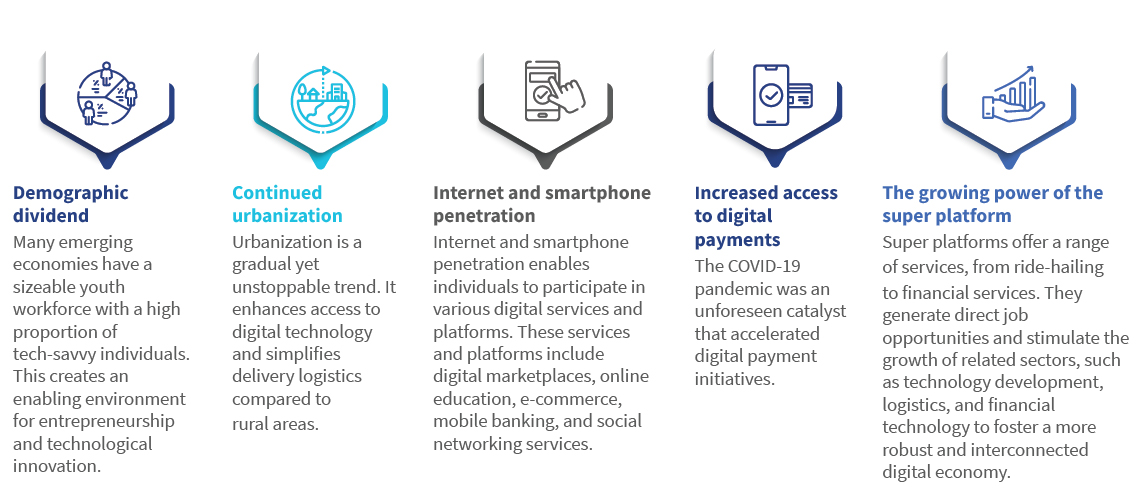From break out to breakthrough: Ways to sustain digital momentum in Indonesia
 by Rhifa Ayudhia and Bianda Kanani
by Rhifa Ayudhia and Bianda Kanani Dec 19, 2023
Dec 19, 2023 6 min
6 min
Indonesia’s digital economy experienced a remarkable 414% growth from 2017 to 2021, but past technological waves have proven that not all economies can capitalize on such momentum. To guarantee meaningful outcomes, the government must prioritize digital public infrastructures, invest in education, and address inclusivity gaps. This blog outlines crucial points to foster an equitable digital economy in Indonesia.
 Behind Jakarta’s bustling business district, a small hawker skillfully prepares batagor, a beloved Sundanese delicacy. Customers form a queue and use Quick Response Code Indonesia Standard (QRIS) to conduct cashless transactions and buy the batagor for IDR 15,000 or approximately USD 1. In this unassuming setting, the seller is a pioneer in the digital realm who mirrors Indonesia’s revolution in the digital economy.
Behind Jakarta’s bustling business district, a small hawker skillfully prepares batagor, a beloved Sundanese delicacy. Customers form a queue and use Quick Response Code Indonesia Standard (QRIS) to conduct cashless transactions and buy the batagor for IDR 15,000 or approximately USD 1. In this unassuming setting, the seller is a pioneer in the digital realm who mirrors Indonesia’s revolution in the digital economy.
Indonesia’s digital economy experienced a remarkable 414% growth from 2017 to 2021, which is projected to grow eightfold from 2017 to 2025. For context, the global digital economy constitutes more than 15% of the world’s GDP and has grown 2.5 times faster than the offline world’s GDP in the past decade.
The Digital Intelligence Index categorized Indonesia and countries, such as India and Kenya, as “Break Out” economies. Despite the challenges of weak infrastructure and institutional capability, these “Break Out” economies are embracing digitalization and technology. They recognize digital technology’s potential to overcome traditional limitations and catch up with developed nations. Digital technology promises to catalyze the transformation of emerging economies, enhance economic productivity, diversify economic sectors, and push these countries into the high-income country bracket.
However, past technological waves have shown that not all emerging economies can successfully seize these opportunities and translate potential into reality. A primary concern for these “Break Out” economies is to convert rapid digital progress into sustainable and meaningful outcomes for their people.
This blog highlights key forces that propel Indonesia’s digital economy forward, explores its challenges, and suggests ways to foster its sustainable growth.
Pivotal forces that propel Indonesia’s progress in the digital economy
Research for Mastercard Foundation highlights five key forces that significantly help accelerate the digital economy. These factors are the demographic dividend, ongoing urbanization, robust Internet penetration, expanded access to digital payments, and increased influence of super platforms. How a country manages these driving forces will determine whether it will remain a “Break Out” country or successfully break through into a higher economic orbit.

Indonesia’s favorable position across all five forces enhances its potential for a breakthrough in the digital economy. Around 50% of its population is under 30. This demographic dividend drives growth and fosters a dynamic environment ripe for technological innovation and entrepreneurship. Moreover, the ongoing trend of urbanization transforms cities into focal points of growth through increased access to digital technologies and job opportunities. Indonesia has a robust presence in the digital space, with a 66% Internet penetration rate and a 47.08% smartphone penetration rate in 2022.
The COVID-19 pandemic accelerated the adoption of digital payments, as seen from the wide adoption of the QRIS. Small-ticket transactions from local merchants and neighborhood shops characterized this trend. Indonesians also use social media a lot. As of February 2022, Indonesia had around 191.4 million active social media users and ranked third after China and India in the Asia-Pacific region.
Additionally, Indonesia has seen a surge in the emergence of tech “unicorns,” such as Gojek, DANA, and eFishery. These tech platforms contribute to the evolution of a well-connected digital economy. They offer diverse services that exemplify Indonesia’s commitment to innovation and its capacity to foster impactful technological advancements.
Indonesia faces immediate challenges despite being well-placed with these five driving forces
The digital economy offers significant economic opportunities but requires concerted efforts to ensure equitable distribution of gains across the population. The most effective route to increase the country’s prosperity is to improve access to economic opportunities for all population segments. A significant number of quality jobs within the economy is crucial to maintain the digital transformation’s momentum.
The Government of Indonesia has announced its initiative to develop Indonesia’s digital economy blueprint. This initiative focuses on infrastructure, human resources, and the innovation ecosystem. In the infographic below, we have highlighted three crucial points that the government should focus on and add to the digital economy blueprint to ensure the digital economy’s sustainable growth.

Develop digital public infrastructures (DPI) as a critical enabler of inclusive digital transformation
DPI includes digital systems and solutions that provide services efficiently to citizens and businesses. The three pillars of DPIs are digital identity, data exchange, and payments. DPIs authenticate citizens uniquely, ensure secure and quick information-sharing across systems, and facilitate seamless financial transactions. Moreover, DPIs show optimal effectiveness when they interoperate with other systems.
The Government of Indonesia has worked hard to advance DPI. For example, efforts are underway to improve the ID system. The government has introduced KTP Digital, an app-based identification system, to ease the transition from physical to digital ID cards. This effort intends to enhance access and strengthen the transparency of citizens’ data. The government has also enacted a regulation to enhance data management across government entities, known as Satu Data Indonesia. On the payments front, the implementation of QRIS streamlines digital payments, which fosters financial inclusion.
Policies should seek to integrate different elements of DPI to support the employment sector. An integrated DPI ensures that reliable identity systems and employment data inform targeted efforts to increase labor force participation, especially women’s participation. Indonesia can adapt lessons from the innovative use of DPIs in other emerging economies, such as India, Kenya, and Nigeria.
Invest in digital education, upskilling, and reskilling programs
Governments should strive for greater inclusion to create a skilled workforce that participates in the digital economy’s growth and benefits from it. The World Bank’s research in Indonesia reveals that higher-skilled workers have gained more from opportunities in the digital economy than their lower-skilled counterparts. Indonesia’s Kartu Prakerja program, which has reached more than 14 million beneficiaries, intends to narrow this gap through accessible upskilling opportunities.
Moreover, sustainable upskilling and reskilling programs must include collaborative public-private initiatives that explicitly seek to empower low-skilled workers in the digital age. This approach ensures that individuals remain relevant and equipped with the skills needed to meet the job market’s evolving demands. MSC’s research explores essential skills in the digital age and addresses why skilling systems are important.
Understand the needs of vulnerable segments, such as women, people with disabilities, and workers in rural areas
Gender disparities persist in the digital economy. Women spend 2.6x more time than men on unpaid care and domestic work, which restricts the time they can spend on paid work or upskill themselves. The pervasive nature of digital work exacerbates this situation as it lacks defined working hours, which drives female workers to work for extended periods. Moreover, women have limited access to digital technologies, which hampers their ability to participate actively in the labor force.
Access to digital platforms and technologies poses significant hurdles for people with disabilities. These issues limit how well they can engage in the digital economy. The lack of inclusive design in software and hardware can further marginalize individuals with disabilities. This restricts their access to educational resources, job opportunities, and online services.
The urban-rural gap is also a persistent issue in Indonesia. People outside Java encounter several barriers to employment due to limited infrastructure, lower education levels, and a lack of diverse economic activities. The rural economy relies significantly on seasonal and informal jobs, such as agriculture. Formal employment in rural Indonesia was as low as 26% in 2022.
The digital economy needs concerted efforts from policymakers, industry players, and local stakeholders to eliminate gender, accessibility, and urban-rural gaps and foster a more inclusive and equitable digital economy.
Indonesia has made remarkable strides in the use of technology for economic growth. However, the path forward needs a collective commitment, which would ensure equitable distribution of benefits, foster a skilled and inclusive workforce, and address the unique challenges marginalized groups face. A comprehensive strategy that combines the strengths of the public and private sectors will help Indonesia sustain its digital momentum and thrive in the digital age.
Written by


Leave comments